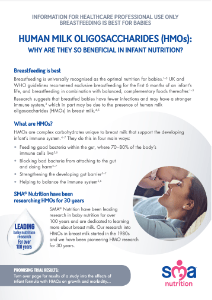Breastfeeding is best
Breastfeeding is universally recognised as the optimal nutrition for babies.1–3 UK and WHO guidelines recommend exclusive breastfeeding for the first 6 months of an infant’s life, and breastfeeding in combination with balanced, complementary foods thereafter.1–3 Research suggests that breastfed babies have fewer infections and may have a stronger immune system,3 which in part may be due to the presence of human milk oligosaccharides (HMOs) in breast milk.4,5
What are HMOs?
HMOs are complex carbohydrates, also known as targeted prebiotics. Unlike other commercial prebiotics such as GOS/FOS, HMOs are unique to breast milk and research suggests that they provide immune support to developing infants.4–7 HMOs have a unique structure which allows them to provide targeted benefits.
They do this in four main ways:
- Selectively feeding good bacteria within the gut, where 70–80% of the body’s immune cells live5,6
- Blocking bad bacteria from attaching to the gut and doing harm5–7
- Strengthening the developing gut barrier5–7
- Helping to balance the immune system5,6
The above benefits have not been shown by GOS/FOS.
SMA® Nutrition have been researching HMOs for 30 years
SMA® Nutrition have been leading research in baby nutrition for over 100 years and are dedicated to learning more about breast milk. Our research into HMO, i.e. targeted prebiotics, started in the 1980s and we have been pioneering HMO research for 30 years.
Effects of infant formula with HMOs on growth and mordbidity8
JOURNAL OF PAEDIATRIC GASTROENTEROLOGY AND NUTRITION
Design & objective:
- Randomised, multicentre, double-blind trial to evaluate the effects of infant formula supplemented with two HMOs* (2’fucosyllactose [2’FL] and lacto-N-neotetraose [LNnT]) on infant growth, tolerance and morbidity
Population:
- Healthy infants, recruited at 0–14 days old, randomised to either control (n=87) or intervention (n=88) group
Primary Endpoint:
- Weight gain (g/day) from baseline to age 4 months
Secondary endpoints:
- Additional anthropometric measures, GI tolerance and behavioural patterns, and morbidity through age 12 months
Results:
Primary endpoint
- No significant difference in weight gain from baseline to age 4 months between groups
Secondary endpoints
Morbidity – infants who received test (vs control) formula had:
- 70% lower risk of parent-reported bronchitis through 12 months of age (P≤0.01)
- 55% lower risk of parent-reported LRTIs through 12 months of age (P<0.05)
- 56% lower use of antipyretics through 4 months of age (P<0.05)
- 53% lower use of antibiotics through 12 months of age (P<0.05)
Digestive tolerance – no significant difference between test and control groups
Stool characteristics – significantly softer stools in test vs control group at 2 months (P=0.021)
Behavioural patterns – fewer night-time awakenings were reported in test group at 2 months (P=0.036); in a subgroup of infants delivered by caesarean section, colic at 4 months was reported less frequently in the test group (P=0.035)
Formula intake – mean daily formula intake was similar between groups
Conclusion:
Infant formula supplemented with HMOs* (targeted prebiotics) 2’FL and LNnT is safe, and assists age-appropriate growth.

Read full article

